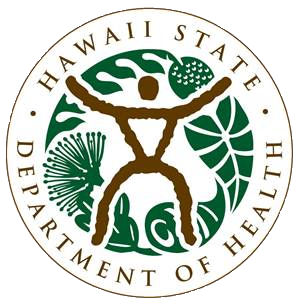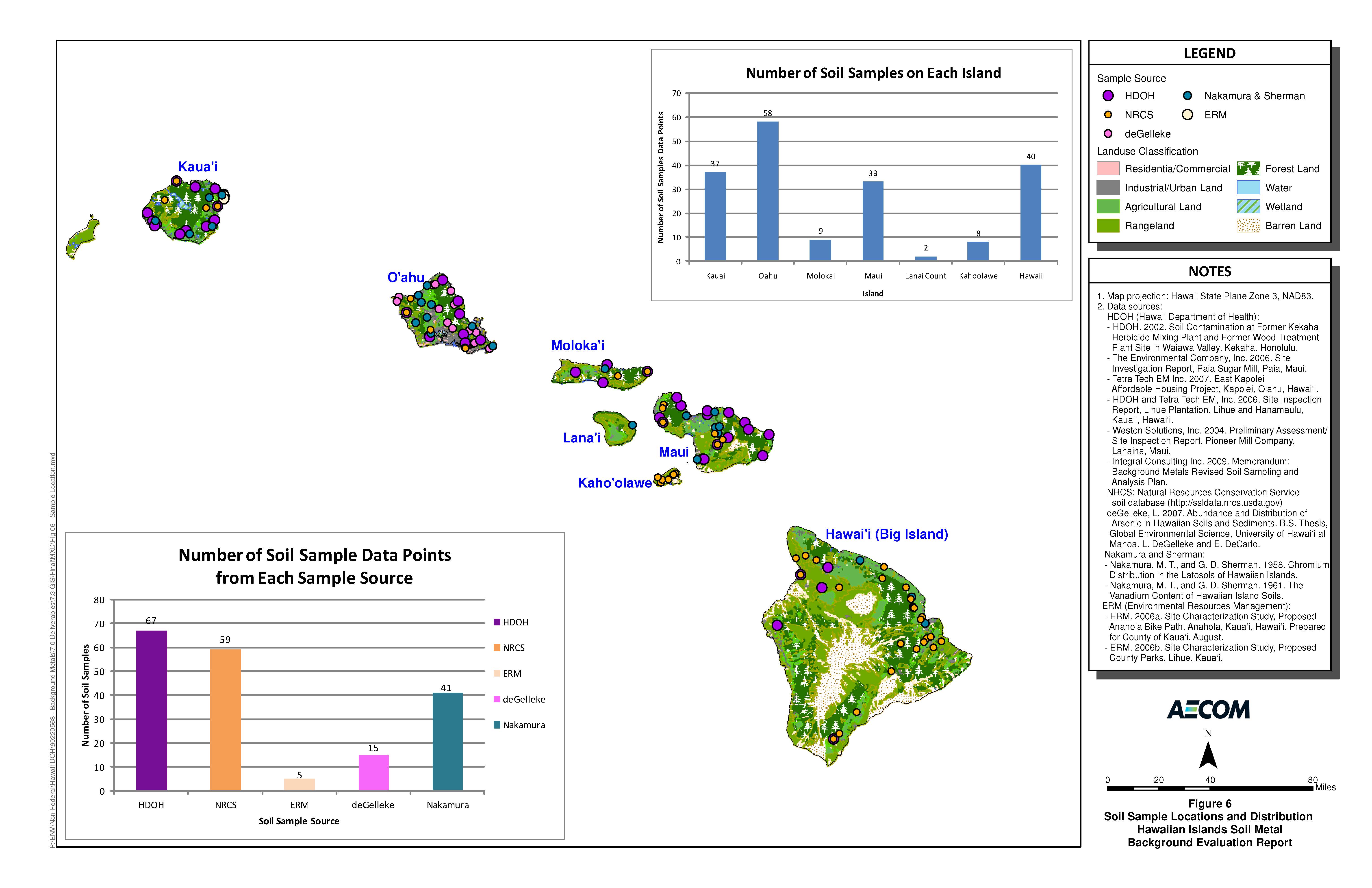This technical memorandum presents a brief overview of how Hawaiʻi-specific background metals concentration ranges were derived and how the data may be used when making site decisions. The Hawaiian Islands Soil Metal Background Evaluation Report (2012) evaluated naturally-occurring, background concentrations of metals and related elements in the volcanic soils of Hawaiʻi.
The database used in the study was compiled from literature review of previous research projects, soil data requested from the Natural Resources Conservation Service database, and soil data collected by the Hawaiʻi Department of Health (HDOH). A total of 180 samples representing surface soil concentrations of 29 chemicals throughout the seven main Hawaiian islands (Kauaʻi, Oʻahu, Molokaʻi, Lānaʻi, Maui, Kahoʻolawe, and Hawaiʻi Island) were included for the background analysis. Samples with probable anthropogenic sources were excluded from the study; therefore, the study results represent the concentration ranges expected to be associated with background conditions and not site-related contamination.
Estimated background ranges of metals and related elements were primarily generated from evaluation of cumulative probability plots and spatial and soil type distribution univariate plots (i.e., the combined plots analysis). The plots were evaluated to determine if the dataset for the target element may represent more than one distinct concentration population. If a single population was identified for the target element, then the data were evaluated to confirm that they most likely represent background conditions. If two or more populations were identified for the target element, detailed spatial analysis, elemental association, geochemical analysis and professional judgment were used to distinguish between concentrations representing background conditions and elevated concentrations that may represent contamination. Estimates made using the combined plots analysis were validated by performing correlation coefficient and geochemical regression studies to analyze the geochemical association of metals that show strong correlation with reference metals (e.g., Al, Fe) in natural soils.
DOWNLOADS
- Hawaiian Islands Soil Metal Background Evaluation Report (2012): Main text, Figures, and Appendix A
- Hawaiian Islands Soil Metal Background Evaluation Report (2012): Appendix B (zipped)
- Summary table comparing background concentration ranges to HDOH Environmental Action Levels (EALs)
PARAMETERS OF EVALUATION
The following parameters for each target element were determined by evaluating the combined cumulative probability and univariate plots:
-
- Upper-bound concentration (UBC): The upper limit of a relatively continuous distribution of assumed natural background concentrations of a metal in soil, excluding outliers. The UBC is estimated based on inflection points and/or gaps in the data distribution from the combined cumulative probability and univariate plots.
- Background threshold value (BTV): The maximum concentration that can be attributed to background conditions based on the data reviewed during this study, which may or may not include natural outliers.
- Outlier: Data points with concentrations that are much higher or lower than the rest of the dataset and do not fit a continuous distribution. Outliers can be attributed to natural enrichment processes, anthropogenic contribution or site contamination.
HOW TO USE THIS DOCUMENT
Detailed guidance that will assist the environmental community in evaluating the use of background concentrations when making site decisions is pending. The results of this study were incorporated into the Fall 2011 edition of the HDOH Environmental Hazard Evaluation Guidance and associated environmental action levels (EALs). Purely risk-based action levels were selected as the final EAL for a metal if the risk-based concentration is higher than the UBC for that metal. If the reported concentration of a metal in soil exceeds the estimated background concentration but does not exceed risk-based action levels then no further evaluation is necessary.
The UBC was selected as the final EAL for a metal if estimated background concentrations are higher than risk-based action levels developed for that metal. For example, background levels of analytes such as antimony, arsenic, cobalt, thallium, and vanadium in volcanic soils can exceed risk-based action levels in volcanic soils under certain geologic conditions. For these analytes, and for elements where EALs do not exist:
-
- Concentrations below the UBC can reasonably be considered background in the absence of known releases of the metal at the site.
- Concentrations exceeding the BTV should be considered highly suspect. In the absence of additional data to support a natural origin, the need for remedial actions should be evaluated.
- In many cases, concentrations between the UBC and BTV can be assumed to be background provided that no anthropogenic sources of releases are known. In some instances, a more detailed research of the geochemistry of soils in the area may be required to determine whether the identified metal is anthropogenic or natural background.
ADDITIONAL DATA
HDOH welcomes environmental professionals to submit background data for metals in soil across Hawaiʻi for inclusion in the Hawaiʻi Background Metals Study. Data should be for soil samples from known locations in Hawaiʻi that are not suspected to be impacted by releases or other anthropogenic activities. Include a description of soil texture, color and composition, as well as geographic coordinates with datum or a map of the approximate location where the sample was collected. Also include a brief a brief summary of the sample collection methodology used (e.g., decision unit size, collection depth, discrete or multi-incremental, etc.). Include all or some portion of the elements summarized in the summary table comparing background concentration ranges to HDOH Environmental Action Levels (EALs). Note the laboratory extraction and analytical methods used. If possible, laboratory extraction methods, analytical methods, and practical quantitation limits (reporting limits) should be comparable to those in the posted HDOH report. Data validated via U.S. EPA PARCCS parameters (precision, accuracy, representativeness, comparability, completeness, and sensitivity) are preferred but this is not a requirement.
For more information, or to volunteer data for the study, please contact Dr. Roger Brewer or Lynn Bailey at (808) 586-4249.

